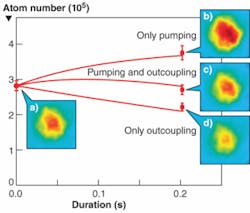Recently reported research results from Australian National University (ANU; Canberra, Australia) appear to pave the way for development of continuous-wave (CW) free-space atom lasers. Atom-optics researchers draw an analogy to the development in optics, after the first ruby laser (a pulsed device), of the first CW optical laser. To the degree that this analogy holds, the field of atom optics, including precision measuring devices such as atom interferometers (www.laserfocusworld.com/articles/292386), may be on the verge of growth analogous to the expansion in optics with the advent of laser sources.
The first atom laser was developed more than ten years ago in the Massachusetts Institute of Technology (MIT; Cambridge, MA) laboratory of Wolfgang Ketterle, just two years after the first Bose-Einstein condensate (BEC) stimulated scattering of ultracold atoms into their lowest possible energy state.1 The process is analogous to the stimulated emission of coherent photons within a laser cavity, with magnetic confinement analogous to laser-cavity mirrors, a thermal cloud of ultracold atoms providing the active medium, a radio-frequency pulse as the output coupler, and the coldness of the condensate analogous to the brightness of an optical laser.
Analogy doesn’t completely hold
Unlike photons, however, which can be created, the number of atoms in an atom laser cavity does not increase and cannot be “amplified.” Only the number of atoms in the ground state is amplified, while the number of atoms in other states decreases.2 Therefore, a primary obstacle to developing free-space, CW atom lasers has been the lack of a continuous source of fresh atoms. To solve this problem, ANU researchers, led by Nicholas Robins, divided it into “two critical components: a delivery system for filling an atomic reservoir with ultracold atoms, and a pumping mechanism for irreversibly and continuously transferring atoms from the reservoir to the laser mode.”3
It turned out that recently developed techniques for optical dipole trapping could be extended to provide the delivery component, but coming up with a pumping mechanism for the atom laser posed a set of problems that the research group again divided into four parts. One was to bring the atoms into the laser mode coherently, with both phase and amplitude matching the lasing BEC. The second was to make the pumping process irreversible. The third was to make the delivery and pumping systems compatible with each other. The fourth was to make the pumping method and outcoupling of the laser beam compatible enough to operate simultaneously.
The researchers used an existing technique: two independent, spatially separated clouds of ultracold atoms in different internal atomic states to provide the source and laser modes. Coupling the two modes involved a three-step process of, first, radio-frequency coupling to an appropriate magnetic state; second, excitation by an optical field resonant only with the source atoms; and third, stimulated transitions from an excited atomic state into the laser mode. Pumping was demonstrated experimentally by measuring the source and laser-mode atom numbers and making a rate equation study of the pumping process.
The experimental apparatus consisted of an ultrahigh vacuum (1011 torr) loaded with 1010 rubidium-87 atoms using a cold atomic beam from a laser-cooled atomic funnel. The atoms were polarization-gradient cooled to about 40 µK and optically pumped into a magnetically trapped ground state. Actual delivery of about 106 of these source atoms over a distance of about 20 cm to the laser BEC was accomplished by using a mechanical translation stage to move the trapping coils. After further cooling, adjacent cigar-shaped Bose-condensed samples (source and laser) were created, with about 106 atoms in each.
The researchers simultaneously ran the pumping mechanism while output-coupling from the laser BEC. Experimentally limited output flux in the atom laser prevented a direct measurement of the number of atoms in the output beam through absorption imaging, so they measured flux indirectly by counting the atoms remaining in the laser-mode BEC after pumping without output coupling, after output coupling without pumping, and then doing both simultaneously (see figure).
Questions remain
Despite this success in demonstrating a continuous pumping methodology, many questions remain about the actual operation of a continuous atom laser. Such questions cannot simply be answered by analogy to an optical laser, due in large part to fundamental differences between optical and atom lasers. For instance, a BEC or atom laser operates in thermal equilibrium at its lowest mode and an extremely low temperature, while an optical laser operates in nonequilibrium and at relatively high temperatures.
So numerous questions about the classical and quantum properties of a pumped atom laser will not be answered until the various theories and methods are actually applied to specific systems. For instance, if an atom laser is operated at a high enough flux to provide what would analogously be referred to in an optical laser as intensity noise suppression, would heating lead to a loss of coherence?
The potential for major advances in fundamental quantum science, precision metrology, and atomic and molecular physics is driving research efforts around the globe. Robins’ team, for instance, is developing a free-space coherent interferometer. A thermal atom interferometer can improve resolution over an optical device by about five orders of magnitude. Using an ultracold atom-laser source can further improve resolution by another three orders of magnitude.4
Such a device might be used in onboard navigation systems that keep precise track of vessel locations without reference to external signals, but instead only on the basis of movements from a known starting point. Applications might include guiding spacecraft beyond the range of global-positioning systems, or directing the covert meanderings of military submarines. “Our aim is to put definitive numbers on the achievable signal to noise for such a device,” Robins said.5
REFERENCES
1. E.A. Thompson, MIT Tech Talk, January 1997.
2. http://cua.mit.edu/ketterle_group/Projects_1997/
atomlaser_97/atomlaser_comm.html
3. N.P. Robins et al., Nature Physics doi:10.1038/nphys1027. Published online July 11, 2008.
4. http://arxiv.org/PS_cache/arxiv/pdf/0712/0712.3703v1.pdf
5. http://www.abc.net.au/science/articles/2008/07/14/2299783.htm?site=science&topic=latest
